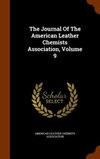碱性金属蛋白酶在枯草芽孢杆菌SCK6中生态脱毛的异源表达
IF 0.5
4区 工程技术
Q4 CHEMISTRY, APPLIED
Journal of The American Leather Chemists Association
Pub Date : 2022-04-01
DOI:10.34314/jalca.v117i3.4892
引用次数: 0
摘要
本研究从耐盐Planococcus halotolerans SCU63T中克隆出碱性金属蛋白酶基因1067,并在枯草芽孢杆菌SCK6中异源表达。以伯塔尼Luria Bertani (LB)肉汤培养基为初始培养基,通过一系列发酵培养优化得到最佳培养基(g/L):酵母浸膏(10)、豆粉(15)、尿素(20)、氯化钾(6.7)、氯化钙(13.3)、NaCl(10)。在最佳培养基的基础上,在30℃、pH为8、接种量为4%、填充量为50 mL的条件下,培养40 h,酶活性最高,为1259.21 U/mL。EDTA抑制蛋白酶活性,PMSF促进蛋白酶活性,表明其为金属蛋白酶而非丝氨酸蛋白酶。蛋白酶的最适反应温度为70℃,最适pH为9。金属离子zn2 +、Co2+和表面活性剂β-ME、Tween 80均能提高蛋白酶的活性。脱毛、扫描电镜和染色结果表明,该金属蛋白酶能完全脱毛。与常规化学脱毛法相比,酶解后的山羊皮质地更柔软,表面更光滑,对山羊皮无明显损伤。本文章由计算机程序翻译,如有差异,请以英文原文为准。
Heterologous Expression of Alkaline Metalloproteinases in Bacillus Subtilis SCK6 for Eco-Friendly Enzymatic Unhairing of Goatskins
In this study, alkaline metalloprotease gene 1067 was cloned from Planococcus halotolerans SCU63T and heterologously expressed in Bacillus subtilis SCK6. Using Luria Bertani (LB) broth medium as the initial medium, the optimal medium was obtained through a series of fermentation and culture optimization (g/L): yeast extract (10), soybean powder (15), urea (20), potassium chloride (6.7), calcium chloride (13.3), NaCl (10). On the basis of the optimal medium, the highest enzymatic activity of 1259.21 U/mL could be obtained by culturing at 30°C for 40 h. with pH 8, inoculation amount of 4% and filling amount of 50 mL. EDTA inhibits protease activity and PMSF promotes it, indicating that it was a metalloprotease rather than a serine protease. The optimum reaction temperature of the protease is 70°C, and the optimum pH is 9. The metal ions Zn 2+, Co2+ and surfactant β-ME, Tween 80 can improve the activity of the protease. The results of unhairing, SEM and staining show that this metalloprotease can completely dehair goatskin. Compared with the conventional chemical method, the goatskin after enzymatic unhairing has softer texture and smoother surface, and there is no obvious damage to the goatskin.
求助全文
通过发布文献求助,成功后即可免费获取论文全文。
去求助
来源期刊

Journal of The American Leather Chemists Association
工程技术-材料科学:纺织
CiteScore
1.30
自引率
33.30%
发文量
29
审稿时长
3 months
期刊介绍:
The Journal of the American Leather Chemists Association publishes manuscripts on all aspects of leather science, engineering, technology, and economics, and will consider related subjects that address concerns of the industry. Examples: hide/skin quality or utilization, leather production methods/equipment, tanning materials/leather chemicals, new and improved leathers, collagen studies, leather by-products, impacts of changes in leather products industries, process efficiency, sustainability, regulatory, safety, environmental, tannery waste management and industry economics.
 求助内容:
求助内容: 应助结果提醒方式:
应助结果提醒方式:


